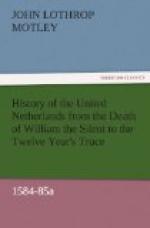But on the death of William, there was a strong reaction against France and in favour of England. Paul Buys, one of the ablest statesmen of the Netherlands, Advocate of Holland, and a confidential friend of William the Silent up to the time of his death, now became the leader of the English party, and employed his most strenuous efforts against the French treaty-having “seen the scope of that court.”
With regard to the other leading personages, there was a strong inclination in favour of Queen Elizabeth, whose commanding character inspired great respect. At the same time warmer sentiments of adhesion seem to have been expressed towards the French court, by the same individuals, than the, mere language of compliment justified.
Thus, the widowed Princess of Orange was described by Des Pruneaux to his sovereign, as “very desolate, but nevertheless doing all in her power to advance his interests; the Count Maurice, of gentle hopes, as also most desirous of remaining his Majesty’s humble servant, while Elector Truchsess was said to be employing himself, in the same cause, with very great affection.”
A French statesman resident in the Provinces, whose name has not been preserved, but who was evidently on intimate terms with many eminent Netherlanders, declared that Maurice, “who had a mind entirely French, deplored infinitely the misfortunes of France, and regretted that all the Provinces could not be annexed to so fair a kingdom. I do assure you,” he added, “that he is in no wise English.”
Of Count Hohenlo, general-in-chief of the States’ army under Prince Maurice, and afterwards his brother-in-law, the same gentleman spoke with even greater confidence. “Count d’Oloc,” said he (for by that ridiculous transformation of his name the German general was known to French and English), “with whom I have passed three weeks on board the fleet of the States, is now wholly French, and does not love the English at all. The very first time I saw him, he protested twice or thrice, in presence of members of the States General and of the State Council, that if he had no Frenchmen he could never carry on the war. He made more account,” he said, “of two thousand French than of six thousand others, English, or Germans.”
Yet all these distinguished persons—the widowed Princess of Orange, Count Maurice, ex-elector Truchsess, Count Holenlo—were described to Queen Elizabeth by her confidential agent, then employed in the Provinces, as entirely at that sovereign’s devotion.
“Count Maurice holds nothing of the French, nor esteems them,” said Herle, “but humbly desired me to signify unto your Majesty that he had in his mind and determination faithfully vowed his service to your Majesty, which should be continued in his actions with all duty, and sealed with his blood; for he knew how much his father and the cause were beholden ever to your Highness’s goodness.”
The Princess, together with her sister-in-law Countess Schwartzenburg, and the young daughters of the late Prince were described on the same occasion “as recommending their service unto her Majesty with a most tender affection, as to a lady of all ladies.” “Especially,” said Herle, “did the two Princesses in most humble and wise sort, express a certain fervent devotion towards your Majesty.”




